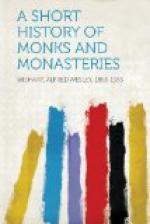The society is distributed into six grades: novices, scholastics, temporal coadjutors, spiritual coadjutors, professed of the three vows, and professed of the four vows.
The professed form only a small percentage of the entire body, and constitute a sort of religious aristocracy, from which the officers of the society are selected. Only the professed of the fourth vow, who add to the three vows a pledge of unconditional obedience to the pope, possess the full rights of membership. This final grade cannot be reached until the age of forty-five, so that if the candidate enters the order at the earliest age permissible, fourteen, he has been on probation thirty-one years when he reaches the final grade.
The society is ruled by a general, to whom unconditional obedience is required. The provinces, into which the order is divided, are governed by provincials, who must report monthly to the general. The heads of all houses and colleges must report weekly to their provincials. An elaborate system of checks and espionage is employed to ensure the perfect working of this complex ecclesiastical machinery. Fraud or evasion is carefully guarded against, and every possible means is employed to enable the general to keep himself fully informed concerning the minutest details of the society’s affairs.
The Vow of Obedience
That which has imparted a peculiar character to the Jesuit and contributed more than any other force to his success, is the insistence upon unquestioning submission to the will of the superior. This emphasis on the vow of obedience deserves, therefore, special consideration. Loyola, in his “Spiritual Exercises,” commanded the novice to preserve his freedom of mind, but it is difficult for the fairest critic to conceive of such a possibility in the light of Loyola’s rule of obedience, which reads: “I ought not to be my own, but His who created me, and his too by whose means God governs me, yielding myself to be moulded in his hands like so much wax.... I ought to be like a corpse, which has neither will nor understanding, or like a small crucifix, which is turned about at the will of him who holds it, or like a staff in the hands of an old man, who uses it as may best assist or please him.”
As an example of the kind of obedience demanded of the Jesuit, Loyola cited the obedience of Abraham, who, when he believed that Jehovah commanded him to commit the crime of infanticide, was ready to obey. The thirteenth of the rules appended to the Spiritual Exercises says: “If the Church shall have defined that to be black which to our eyes appears white, we ought to pronounce the thing in question black.”




